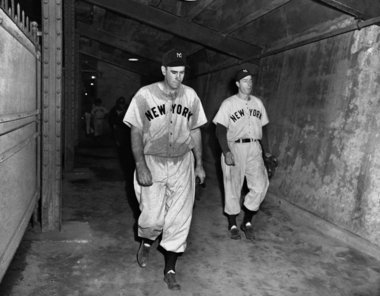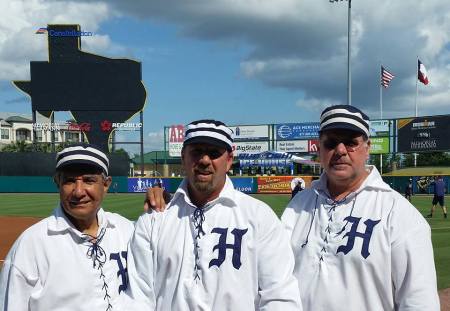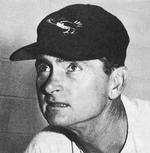
World Series Game 4, Oct. 3, 1947, Yankees vs. Dodgers at Brooklyn. Dodgers win, 3-2, on last pitch with their first hit of the game. Lavagetto's double ties Series. Pitcher Floyd Bevens & Joe DiMaggio walk away from heartbreaking loss at Ebbets Field.
Had it not been for a single pitch on a singular afternoon on an Indian Summer day back in Brooklyn in 1947, it’s likely that even fewer people would remember the name of the late Floyd “Bill” Bevens these 63 plus years later. But baseball people remember him – for what he did and didn’t do.
With the Yankees tying into their second World Series competition against their down-from- “snob hill” neighbors, the Brooklyn Dodgers, the Yankees were leading the Series, 2-1, through three games, but their pitching corps was running thin do a combination cause of injury, tiredness, and a general lack of normal Yankee talent. As a result, Manager Bucky Harris made the call to go with a little known, but not-too-accomplished right hander named Floyd “Bill” Bevens.
Bill Bevens brought a 1947 season record of 7-13 and a 3.82 ERA into Game Four. In his four seasons in the major leagues (1944-1947), all played as a WWII talent shortage Yankee roster guy, Bevens had achieved the unremarkable record of 40-36 and a 3.08 career ERA.
Bevens settled on Game Four to have the best stuff of his life. He had control problems, walking 10 against only 5 strikeouts, but had surrendered no hits in guiding the Yankees into the bottom of the 9th with a 2-1 lead. He also had thrown a ton of pitches, far more than his tired aching arm could handle, but this was 1947 and nobody did pitch counts back then. On top of the cultural value from that era that said “pitchers should finish what they start,” the man had a no-hitter going. No way Harris was going to take him out in favor of ace reliever Joe Page.
Then came the 9th.
 With two outs, Bevens walked center fielder Carl Furillo. Dodger Manager Burt Shotton then quickly subbed the speedy Al Gionfriddo as a pinch runner for Furillo. Gionfriddo then quickly took off for 2nd, getting there about the same time a great throw from catcher Yogi Berra to shortstop Phil Rizzuto.
With two outs, Bevens walked center fielder Carl Furillo. Dodger Manager Burt Shotton then quickly subbed the speedy Al Gionfriddo as a pinch runner for Furillo. Gionfriddo then quickly took off for 2nd, getting there about the same time a great throw from catcher Yogi Berra to shortstop Phil Rizzuto.
The Yankees thought for sure they had the third out – the win – the first World Series no-hitter in history – and a 3-1 lead in games for the 1947 World Series!
No. No. No. Much to the Yankees’ dismay, Gionfriddo got the safe call. The game would play on – with the tying run now on 2nd and the dangerous Pete Reiser coming to bat for Brooklyn.
That’s when Yankee manager broke the yolk of baseball wisdom that usually bridled these situations. He made the call to Bevens for an intentional walk of the once speedy, but now more hobbled Pete Reiser, putting the winning run on 1st with two outs in the bottom of the 9th.
Bevens would face the pesky, but powerless Eddie Stanky with the tying runner on 2nd and the winning run at 1st, needing only that one more out to nail down his place in World Series history.
Hold up again. Dodger mentor Shotton had other ideas. Instead of facing Stanky, Bevens would face the right-handed veteran Cookie Lavagetto as a pinch hitter. Cookie wasn’t a power hitter, but he did possess some pop in his bat that Stanky could only have dreamed about. Shotton’s move provoked no further adjustments by Harris. It would be left up to righty Bevens and righty Lavagetto to write the next big moment in World Series history.
Shotton of Dem Bums had one more move. He inserted the faster Eddie Miksis at 1st as a pinch runner for the intentionally walked Reiser.
The final battle was now joined. Bevens vs. Lavagetto, with young Yankee catcher Yogi Berra relying upon the clubs book that said they could get Cookie with a fastball, high and away. And that’s what Bevens threw. And Lavagetto flailed away and missed for strike one on the very first pitch.
Yogi called for another hard one, high and away on the second pitch to Cookie. Bevens had second thoughts, but he delivered it anyway. This time, Lavagetto reach our and up and got it. A loud crack resounded, inciting a moment of stunned silence, then a roaring wave of euphoria from the home crowd as the ball bounced high off the screen in right field.
Gionfriddo easily scored the tying run. And here came Miksis from first on his teammate’s heels with the winning run. The Dodgers got only their first hit of the game from Lavagetto, but it was enough to produce a 3-2 Dodger win, tying the Series at 2-2 in games, and destroying Bill Bevens’s bid to become the first pitcher in history to throw a no-hitter in a World Series.
Bill Bevens lost more than a no-hitter that day. He pretty much ruined his arm pitching that game. Aside from some brief relief work after Game Four, Bevens would never pitch for the Yankees, or any other big league club again after 1947. The Yankees did win the Series in seven games, of course, and Bevens will always have that association to his credit, but all he would get from the Yankees in 1948 is his unconditional release in spring training.
The stories of Bill Bevens walking off the mound in tears that day at Ebbets Field, as well as those memories of Bevens and Yogi crying together in the clubhouse, all fly in the face of that “no crying in baseball” myth. That loss had to hurt bad. I concede the guy’s right to his expression of pain from that very hurtful experience.
Like no other sport, baseball moves deliberately through a succession of events that eventually determine winning or losing, joy or despair. Can you imagine the nanosecond of joy that must have spawned in the Yankee dugout when they thought they had thrown out Gionfriddo at 2nd for the final out of the game?
Didn’t happen. Keep playing. Keep playing until the cracking sound of Lavagetto’s bat is your final memory of this game, for better or worse.
Floyd “Bill” Bevens kept on playing minor league ball beyond 1947. In fact, in his 14 seasons as a minor leaguer from 1937 to 1953, he compiled a minor league record of 117-118 and a career ERA of 3.76. He could have retired with a winning record in 1952 but he came back in 1953, just long enough to take it into the negative side with an 0-2 mark at Salem of the Class A Western International league.
Bevens’s minor league history even included a brief stopover in 1949 with the Houston Buffs. Bevens was a Buff only long enough to give up six hits in four innings and two games with no record before moving on to Seattle of the Pacific Coast League that same season.
In the end, it was the legacy of Floyd “Bill” Bevens to be the man who lost a chance to post the first no-hitter in World Series history with two outs in the 9th inning. Perhaps, the question is: Did Bevens really lose his no-hitter to Lavagetto’s walk-off double – or did he earlier in the 9th lose it to Gionfriddo’s safe call on the steal of 2nd?
Bill Bevens passed away at his home in Salem, Oregon on October 26, 1991 at the age of 75.
























